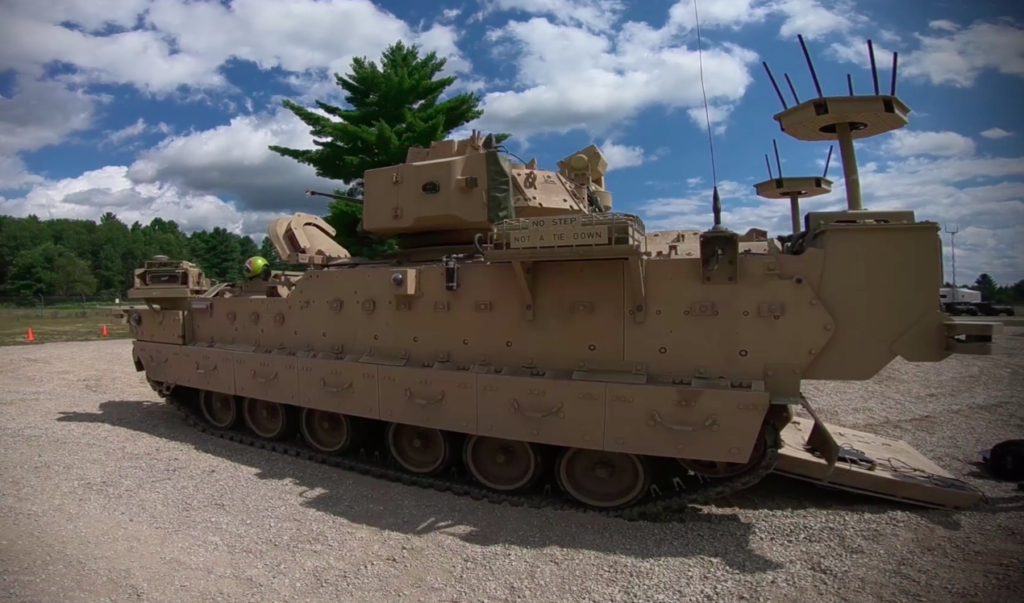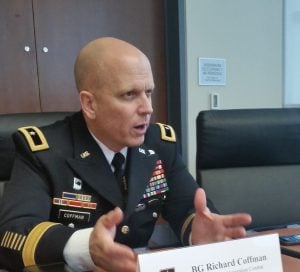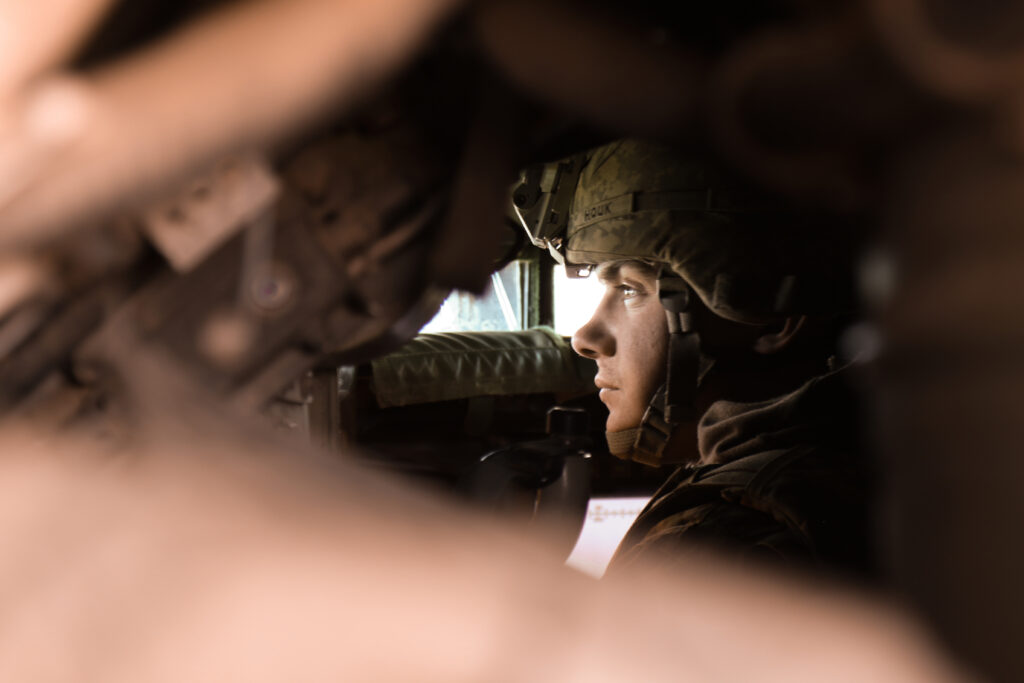
A MET-D, an M2 Bradley modified to carry the remote-control stations for unmanned vehicles.
WASHINGTON: Field tests and computer models have convinced the Army that future armored vehicles can fight with just two human crew, assisted by automation, instead of the traditional three or more, the service’s armor modernization chief told me.

Brig. Gen. Ross Coffman
That confidence drove the Army, in its draft Request For Proposals released on the 17th, to require a two-soldier crew for its future Optionally Manned Fighting Vehicle. The OMFV is scheduled to enter service in 2028 to replace the Reagan-era M2 Bradley, which has the traditional trio of commander, gunner, and driver. (Both vehicles can also carry infantry as passengers, and the Army envisions the OMFV being operated by remote control in some situations).
The Army has already field-tested Bradleys modified to operate with a two-soldier crew instead of the usual three, said Brig. Gen. Richard Ross Coffman, the director of Army Futures Command’s Cross Functional Team for Next Generation Combat Vehicles. “As we speak,” he told me in an interview last week, “we’ve got those Mission-Enabling Technology Demonstrators, or MET-D, actually maneuvering at Fort Carson, Colorado, as part of the Robotic Combat Vehicle test.”
With the benefit of modern automation, Coffman said, those two-soldier crews have proven able to maneuver around obstacles, look out for threats, and engage targets — without being overwhelmed by too many simultaneous demands. “They’re doing that both in simulation and real world at Carson right now,” Coffman told me.
“You have two humans with a virtual crewmember that will remove cognitive load from the humans and allow the functions of gunning, and driving, and commanding the vehicle to be shared between humans and machines,” Coffman said. “We think that the technology has matured to the point where …this third virtual crewmember will provide the situational awareness to allow our soldiers to fight effectively.”
The defense contractors who would have to build the vehicle – even if a government team designs it – aren’t so sure. “A two-man crew will be overwhelmed with decision making, no matter how much AI is added,” one industry source told me.

A soldier trains in the cramped interior of a Bradley.
A Persistent Dilemma
For at least eight decades, combat vehicle designers have faced a dilemma. A smaller crew allows a smaller vehicle, one that’s cheaper, lighter, and harder to hit – and if it is hit, puts fewer lives at risk. But battlefield experience since 1940 has shown that smaller crews are easily overwhelmed by the chaos of combat. Historically, an effective fighting vehicle required a driver solely focused on the path ahead, a gunner solely focused on hitting the current target, and a commander looking in all directions for the next target to attack, threat to avoid, or path to take. (Many vehicles added a dedicated ammunition handler and/or radio operator as well).
A “virtual crewmember” could solve this dilemma — but will the technology truly be ready by the late 2020s?
The Army actually tackled this question just last year and came to the opposite conclusion. You see, the draft Request For Proposals released last week is the Army’s second attempt to launch the OMFV program. In March 2019, the Army issued its original RFP for an Optionally Manned Fighting Vehicle. In most respects, the 2019 RFP was much more demanding than last week’s draft: It wanted the vehicle in service two years earlier, in 2026 instead of 2028, and it had such stringent requirements for weight and amor protection that no company managed to meet them, leading the Army to start over. But for all its ambition in other aspects, the 2019 RFP did not mandate a two-person crew; that’s a new addition for the 2020 version.
It’s worth noting that just one company managed to deliver a prototype by the Army’s original deadline in 2019: General Dynamics. They built their vehicle to operate with a crew of three – but with the option to go down to two as automation improved.
At the same time, the Army started experimenting with Robotic Combat Vehicles that had no human crew aboard at all. The long-term goal is to have a single soldier oversee a whole wolfpack of RCVs, but the current proto-prototypes are operated by remote control, with a crew of two: a gunner/sensor operator and a driver. The Army has been impressed by how well these teleoperated RCVs have performed in field trials. If two soldiers can effectively operate a vehicle they’re not even in, might two be enough to operate a manned vehicle as well?
The other piece of the experimental RCV unit is the mothership, an M2 Bradley with its passenger cabin converted to hold the teleoperators and their workstations. These modified M2s, called MET-Ds, also operate with just two crewmembers, a gunner and a driver – without a separate commander – and, says Coffman, they’ve done so successfully in combat scenarios.
The Army is not just adding automation to individual vehicles. It’s seeking to create combined units of manned and unmanned war machines that share data on threats and targets over a battlefield network, allowing them to work together as a seamless tactical unit that’s far more than the sum of its parts. “This [vehicle] will not fight alone, but as part of a platoon, a company, a battalion,” Coffman said. “The shared situational awareness across that formation will transform the way we fight.”

The M2 Bradley has been repeatedly upgraded since its introduction, but after 40 years in service, the vehicle is reaching its limits.
What Has Changed?
These ongoing experiments are the latest in a long series. “As far back as 1991, the Army was looking at reducing the number of crew members,” Coffman told me. “Back then, when I was just coming in the Army, the tech had not matured to the point that it would allow a two-person crew.”
But that was then, Coffman said. Three decades later, with the rise of the iPhone, Google Maps, and a booming business in artificial intelligence, the times and the technology have changed.
“Since then, our 360-degree situational awareness has vastly improved,” Coffman said. Instead of peering through periscopes, gunsights, and slit-like bulletproof windows – or just sticking their head out the hatch and hoping there’re no snipers around – crews can look at wide-screen displays fed by multiple cameras and other sensors mounted all around their vehicle. Automated target recognition systems can analyze the sensor feeds in real time, identify potential threats and targets, alert the crew to their presence, and even automatically bring the main gun to bear. (The Army still requires a human decision to fire). Waypoint navigation algorithms, obstacle sensors, and automated collision avoidance routines can ease the task of maneuvering 40-plus-tons of metal around the battlefield.
Could all this technology unburden the human crew, allowing just two soldiers to operate a combat vehicle, instead of needing one solely focused on driving, a second solely focused on shooting, and a third giving direction to the other two? The Army now thinks so.
That said, the newly released Request for Proposal is a draft, being circulated specifically to get feedback on what’s feasible. If too many companies say the two-person crew won’t work, the Army can still change that requirement before the final RFP comes out next April.
“I think they are learning, through their experimentation, that it’s a high-risk requirement,” one industry source told me. “However, I think it’s like anything else involving technology: Given time — and money — it’s achievable.”
Sullivan: Defense industry ‘still underestimating’ global need for munitions
National Security Advisor Jake Sullivan said that there are “no plans” for another Ukraine supplemental at this point.


























